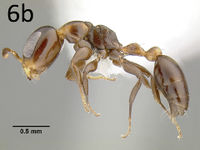Pseudomyrmex micans
| Pseudomyrmex micans | |
|---|---|

| |
| Scientific classification | |
| Kingdom: | Animalia |
| Phylum: | Arthropoda |
| Class: | Insecta |
| Order: | Hymenoptera |
| Family: | Formicidae |
| Subfamily: | Pseudomyrmecinae |
| Genus: | Pseudomyrmex |
| Species group: | goeldii |
| Species: | P. micans |
| Binomial name | |
| Pseudomyrmex micans Ward, 2017 | |
As currently conceived P. micans is known only from rainforest sites in Peru (nest ex dead twig, edge of second-growth rainforest) and Bolivia (workers foraging on recent Tabebuia and Hymenaea treefalls). (Ward, 2017)
Identification
Ward (2017) - Based on the weakly angulate propodeum this species was initially considered conspecific with Pseudomyrmex goeldii (and called this in Chomicki et al. 2015), but a more careful examination of relevant material reveals substantial differences: P. micans is smaller in size (HW 0.52–0.55 versus HW 0.65–0.66 in the three syntype workers of goeldii), and has more elongate eyes (REL 0.59–0.61 versus 0.55–0.56), a shorter petiole (PLI 0.64– 0.69 versus 0.51–0.59), and a more shiny mesosoma. P. micans appears to be closely related to Pseudomyrmex laevifrons, differing primarily by the less pronounced angular juncture of the dorsal and declivitous faces of the propodeum; by the weaker body sculpture, especially on the metapleuron, which is more strongly shining; by slightly lower REL2 values (see above); and by the shape of the petiole, which is lower, wider, and with a more gently sloping anterodorsal face (compare Figs 5b and 6b). Collections from Peru and Bolivia can be separated into one or the other of these two forms, based on the features listed above. This includes diagnostic differences in petiolar metrics: PLI 0.72–0.80 in P. laevifrons (n = 5) versus 0.64–0.69 in P. micans; DPW/PH 0.76–0.85 in P. laevifrons versus 0.88–0.92 in P. micans. In other parts of the range of P. laevifrons, where P. micans is apparently absent, the petiolar diagnostics break down, and some workers show a weakening of the pronounced angle at the juncture of the dorsal and declivitous faces of the propodeum. One interpretation of this pattern is that P. laevifrons ranges from Central America to Bolivia and central Brazil, undergoing character displacement where it overlaps with the more southern species, P. micans. An alternative hypothesis is that the species are distinct in some areas but that differences are obscured by gene flow elsewhere. The entire complex of populations would benefit from a focused phylogenetic analysis.
Keys including this Species
Distribution
Distribution based on Regional Taxon Lists
Neotropical Region: Bolivia, Peru (type locality).
Distribution based on AntMaps
Distribution based on AntWeb specimens
Check data from AntWeb
Countries Occupied
| Number of countries occupied by this species based on AntWiki Regional Taxon Lists. In general, fewer countries occupied indicates a narrower range, while more countries indicates a more widespread species. |

|
Estimated Abundance
| Relative abundance based on number of AntMaps records per species (this species within the purple bar). Fewer records (to the left) indicates a less abundant/encountered species while more records (to the right) indicates more abundant/encountered species. |

|
Biology
As currently conceived P. micans is known only from rainforest sites in Peru (nest ex dead twig, edge of second-growth rainforest) and Bolivia (workers foraging on recent Tabebuia and Hymenaea treefalls).
Castes
Nomenclature
The following information is derived from Barry Bolton's Online Catalogue of the Ants of the World.
- micans. Pseudomyrmex micans Ward, 2017: 536, fig. 6 (w.m.) PERU.
Unless otherwise noted the text for the remainder of this section is reported from the publication that includes the original description.
Description
Worker
(n = 6). HL 0.67–0.74, HW 0.52–0.55, MFC 0.007–0.009, LHT 0.39–0.42, CI 0.74– 0.80, REL 0.59–0.61, REL2 0.75–0.80, FCI 0.013–0.016, FI 0.53–0.55, PLI 0.64–0.69, PWI 0.56–0.63.
Small species (HL 0.67–0.74, HW 0.52–0.55) with elongate head and eyes (CI 0.74–0.80, REL 0.59–0.61, REL2 0.75–0.80); masticatory margin of mandible with 5 teeth; palp formula 4,3; juncture between dorsal and declivitous faces of propodeum only weakly angulate, not producing lateral tubercles; anterodorsal face of petiole ascending gently (Fig. 6b). Head smooth and shiny with scattered fine punctulae; pronotum similar, remainder of mesosoma becoming sublucid, with coriarious-imbricate sculpture on most surfaces, but with shining areas on the mesopleuron and metapleuron; petiole, postpetiole and gaster with moderately dense pubescence. Standing pilosity sparse (MSC 2); paired erect setae present on pronotal humeri, petiole and postpetiole. Dark brown, mandibles, frontoclypeal complex and tarsi lighter; pronotum, petiole and postpetiole sometimes a lighter medium- to yellowish-brown.
Type Material
Holotype worker. PERU San Martín: Tarapoto, 350 m, 6°29ʹS, 76°22ʹW, 25 Aug 1986, ex dead twig, edge of second-growth rainforest, P. S. Ward PSW08734 (Museu de Zoologia da Universidade de Sao Paulo) (CASENT0794101). Paratypes. Series of workers, 1 male, same data as holotype (California Academy of Sciences, John T. Longino Collection, Museum of Comparative Zoology, Philip S. Ward Collection, University of California, Davis, National Museum of Natural History).
References
- Cantone S. 2018. Winged Ants, The queen. Dichotomous key to genera of winged female ants in the World. The Wings of Ants: morphological and systematic relationships (self-published).
- Ward, P.S. 2017. A review of the Pseudomyrmex ferrugineus and Pseudomyrmex goeldii species groups: acacia-ants and relatives (Hymenoptera: Formicidae). Zootaxa 4227: 524–542 (doi: 10.11646/zootaxa.4227.4.3).
